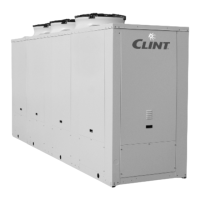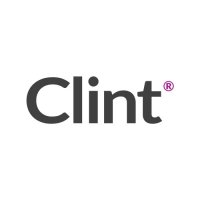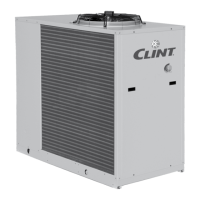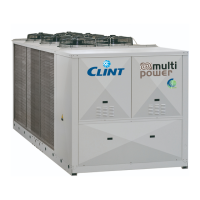12
-
- Wyrzucanie elementów, spadających na łopatki wen-
tylatora.
- Wyciek wody (w przypadku awarii).
- Tworzenie się kondensacji i lodu na przedzie urządze-
nia podczas pracy pomp ciepła.
- Zmiana mikroklimatu (w czasie pracy).
- Hałas (w czasie pracy). Poziom ciśnienia akustyczne-
go każdego z urządzeń podano w opisie technicznym.
- Wycieki oleju (w przypadku awarii).
- Wycieki czynnika (w przypadku awarii).
3.4 EMERGENCY AND SAFETY DEVICES
An emergency external circuit breaker must
be fitted by the unit installer to disconnect
the unit from the power supply.
3.5 DESCRIPTION OF RESIDUE RISKS
The description of residue risks includes the following
elements:
- the kind of danger the people working on the unit are
subjected to;
- description of the main dangers;
- who is exposed to such dangers;
- the main safety methods used to reduce the risk of
injury.
The following accident prevention instructions, with
reference to the relative areas concerned by residue
risks, must be integrated with all the general indications
contained in the present chapter and with the accident
prevention regulations in force in the country of instal-
lation.
3.5.1 Residue risks near the unit
- Electrocution if the unit is not properly corrected to the
mains power supply and earth circuit.
- Cuts or abrasions caused by sharp surfaces.
- Extraction and subsequent dispersion in the envi-
ronment of substances present in the installation
site.
- Ejection of objects falling on the fan blades.
- Leaking water (in case of malfunction).
- Formation of condensation and ice in front of the unit
while the unit heat pumps are working.
- Alteration of the micro climate (during operation).
- Noise (during operation).The sound pressure levels
of each unit are carried in technical manual.
- Leaking oil (in case of malfunction).
- Leaking refrigerant liquid (in case of malfunction).
N.B. Refrigerant liquid is a substance which causes a
greenhouse effect. Its vapours are heavier than
air and can cause suffocation by reducing the
amount of oxygen available for breathing. Rapid
evaporation of the liquid can cause freezing to
occur.
3.4
ZABEZPIECZENIA I URZĄDZENIA AWARYJNE
Awaryjny przerywacz obwodu musi zostać
zamontowany w pobliżu urządzenia w celu
odłączania go od zasilania.
3.5 OPIS POZOSTAŁYCH ZAGROŻEŃ
Opis pozostałych zagrożeń obejmuje następujące ele-
menty:
- typ zagrożenia, na jakie narażeni są użytkownicy;
- opis głównych niebezpieczeństw;
- kto jest na nie narażony;
- podstawowe zasady bezpieczeństwa stosowane
w celu uniknięcia obrażeń.
3.5.1
Pozostałe zagrożenia w pobliżu jednostki
- Porażenie prądem w przypadku nieprawidłowego po-
dłączenia urządzenia do zasilania i uziemienia.
-
Skaleczenia i obtarcia spowodowane ostrymi powierz-
chniami.
- Wyciek do atmosfery substancji obecnych w instalacji.
N.B. Ciekły czynnik jest substancją powodującą efekt
cieplarniany. Jego opary są cięższe od powietrza
i mogą spowodować uduszenie na skutek redukcji
ilości tlenu niezbędnego do oddychania. Szybkie
odparowanie cieczy może być przyczyną zamar-
znięcia układu.
Poniższe instrukcje, opisujące sposoby zapobiegania
wypadkom, z odniesieniem do właściwych obszarów
narażonych na wystąpienie pozostałych zagrożeń,
muszą być stosowane łącznie z wszystkimi ogólnymi
wskazówkami opisanymi w bieżącym rozdziale oraz z
przepisami bezpieczeństwa obowiązującymi w kraju,
gdzie montowane jest urządzenie.

